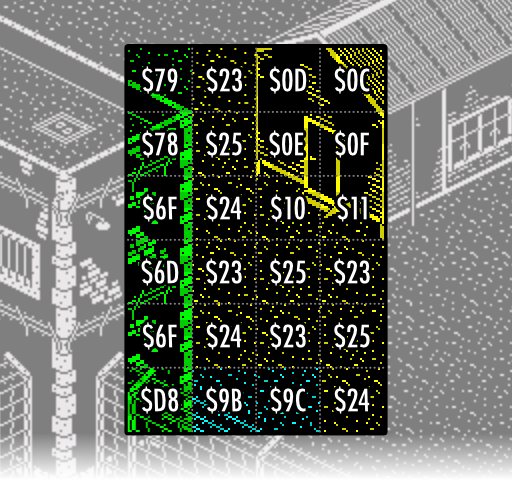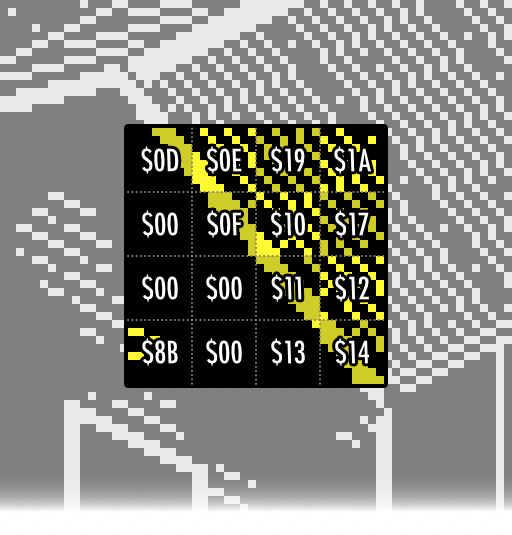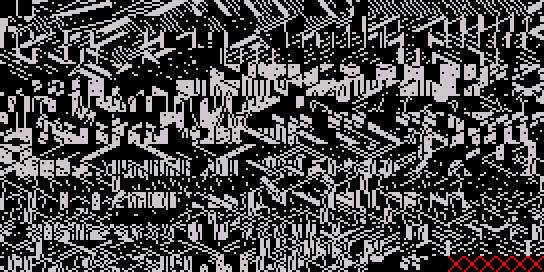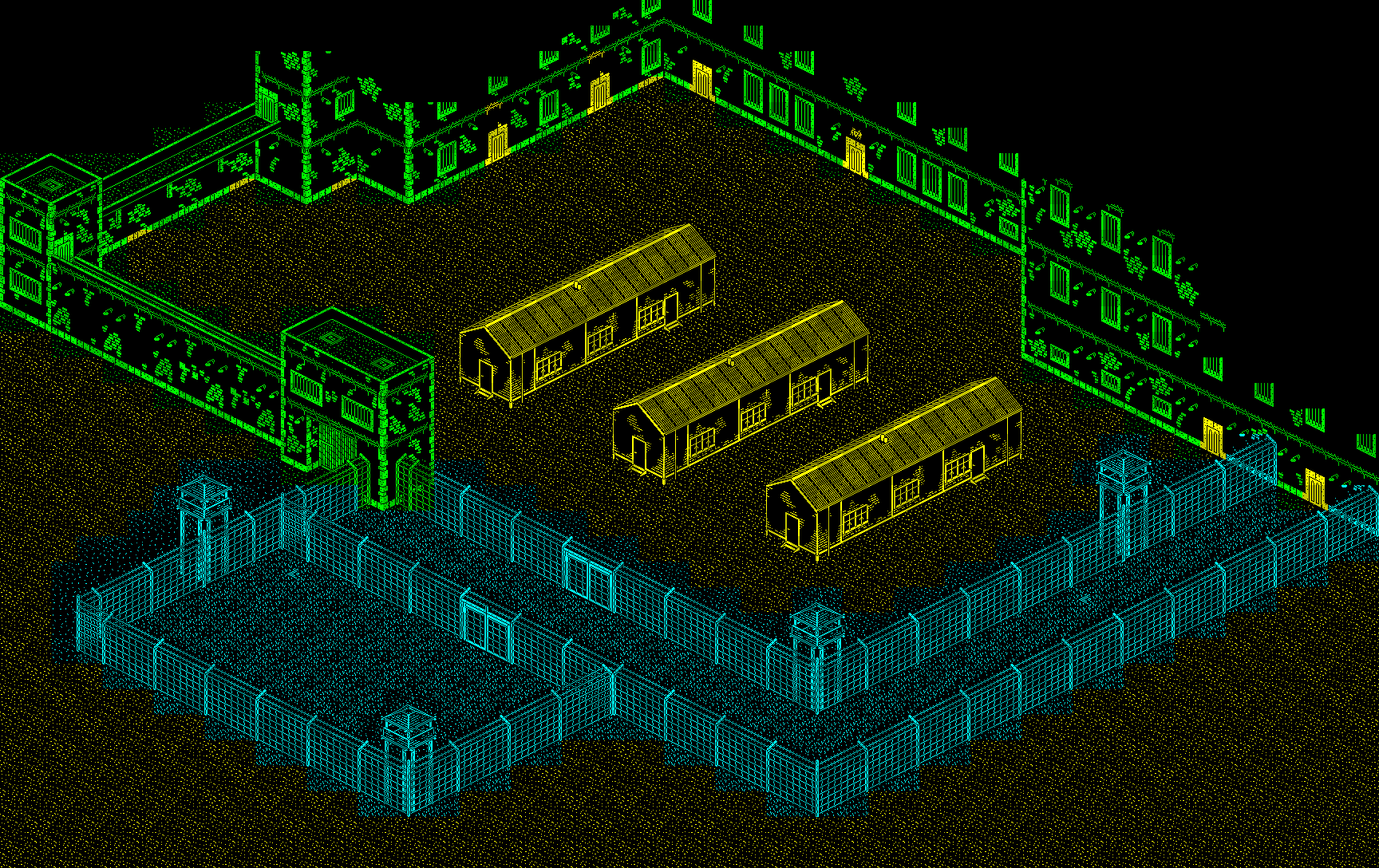The Great Escape > Discoveries
Table of Contents
Discoveries & Surprises
So, what did I find that was surprising to me when reverse engineering the game?
There’s Only Six Prisoners!
The cast of the game consists of:
- Our Hero
- The Commandant
- Guards 1 to 15
- Guard dogs 1 to 4
- Prisoners 1 to 6
Wait… there’s fifteen guards, but only six prisoners? With three huts in the camp, and four beds in each hut, there should be at least double that number, right? True, but creepily the topmost hut contains only sleeping prisoners which never move…
You Can Escape Through the Main Gate!
It was news to me: if you’re wearing the guard’s uniform, and have the papers from the commandant’s office, you can use the papers while at the front entrance to be transported outside of the camp.
There’s Nothing Really Higher Up!
The parts of the map you can’t normally see are just blank tiles:

Clearly Myrck/Pavero’s version of the map from 2006 cleaned up the real thing a bit for presentation.
Because of this if one were to change the resolution that the game runs at you’d start to see these gaps and the exterior map would need amending.
Line of Sight!
The guards have a direct line of sight system. You can sneak around behind them without them noticing.
Objects are People Too!
The movable items in the game - the two stoves and one crate which can be pushed around - are implemented in the game as characters. A bug that omits a test means you can bribe these objects, at which point they start cycling through broken visuals and wandering around the room…
A Double Buffered Screen!
One surprise was to discover that the main game window is double-buffered. This removes flicker and this makes it easier (possible) to build up the screen as well as facilitating smoother scrolling. The buffer is not cheap: it uses 3.3K of RAM.
Fuller Joystick Support!
It’s in there, but not attached to anything…
The IX Register Goes Unused!
The game never uses the Z80 IX register, but it does use IY.
The Exterior Map Backdrop
The game’s exterior map backdrop is stored in an interesting manner. It acts like a huge two-colour monochrome (“bilevel”) bitmap, but it’s really a cunningly-encoded data structure which utilises redundancy at two levels of detail.
If rendered normally a 1,728 * 1,088 bilevel bitmap like this would occupy 235,008 bytes, but the compression permittted by the redundancy present at both the 8x8 and 32x32 block sizes allows it to compress into just 9,892 bytes.
In fact, the reverse is probably true: small pieces of map were likely drawn and built up into larger sections piecemeal, resulting in an efficiently encoded map.
Encoding
The main map is a 2D array, 54 by 34, of indices of super-tiles (my terminology). Each index covers a 32x32 pixel area. The Great Escape’s map uses 218 unique super-tiles.
Let’s examine an area of map near to the front gate (the colouring is mine, $ denotes hex):

The super-tiles are in turn made of 4x4 indices of small tiles. We can zoom in on super-tile $0C, which is part of the hut’s roof, to see the indices it uses:

And those indices index the complete set of 571 8x8 map pixel tiles:

But things aren’t that simple! Because there are over 256 small tiles these values won’t fit in a byte. The map is setup so that there are three groups of super-tiles that each use different ranges of small tiles.

In the diagram above I’ve used yellow, green and blue to show super-tiles which use different sections of the map tiles. This sliding window approach means that some tiles are known by two different indices, depending on which super-tile accesses it.
A Map Compressor?
Fascinated by this compression I was interested to see if I could decompress the main map’s data into a flat bitmap and recompress it back to the same level.
I built a map recompressor tool which analysed the map and attempted to reconstruct it using three different techniques, where various sorting/grouping ideas were tried out. To summarise: no, I couldn’t find a method to compress as well as the original game. I have a separate page part-written somewhere which attempts to explain the problem in an appeal to someone more cleverer than I to see if a compressor is possible, or if the ‘perfect’ compression used in the game is the result of human construction.
Lumpy Performance
The Great Escape has something of a lax approach to timing. There’s no vsync synchronisation etc. The game runs at whatever speed it can manage. You can normally gauge the speed of the game by how fast the morale flag waves up and down.
Having many characters on-screen (e.g. more than 4) will often make the game lag. But even with that in mind sometimes the flag seems too slow.
Analysis of the code reveals that there are two routines which blit the back-buffered linear map view onto the Spectrum’s main screen. The first is a quick routine which just copies as fast as it can, but the second does a 4-bit roll in order to give the game more scrolling resolution. The trouble is that the first routine is understandably faster than the second.
Once you’ve spotted this you realise that the slowness is just when the character is on an ‘odd’ alignment and the slow routine is in use.
Isometric Projection
The “isometric” projection used in The Great Escape is, like many of its pixel-bound contemporaries, actually a dimetric projection. Isometric means “having equal dimensions” e.g. a trio of 120 degree angles. However the angles used by The Great Escape are approximately 117:117:126 degrees. 1 2
The Great Escape stores an (x,y,z) map position for each character. To place a character or object on-screen we must project its point into isometric 2D. The standard fast method for computing an isometric projected point is:
x' = x - z
y' = y + (x + z) / 2
However The Great Escape uses:
x' = (64 + z - x) * 2
y' = 256 - x - z - y
(Notation note: ‘y’ in the game code is ‘z’ here and ‘height’ in the game code is ‘y’ here).
This has the effect of flipping the projected coordinates horizontally and vertically as well as doubling the size of the output and shifting it around a bit. Why is it this way instead of the standard method? I’m not exactly sure but removing the division is a likely explanation. (Well, the map’s authored flipped h/z compared to the isometric projected map).
Example: The middle home hut at <94,82..98,98> in the game map becomes <104,80 - 96,76 - 128,60 - 136,64> when projected.
In addition see that in The Great Escape the ‘y’ (height) value is divided by two. I’m unsure if this is intentional. It means that heights will be ‘worth’ half as much in terms of movement compared to the standard method.